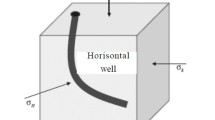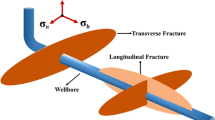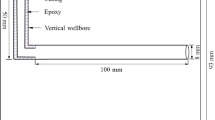Abstract
In this study, hydraulic fracturing tests were conducted on 10 and 15 cm synthetically manufactured cubic tight mortar samples. The use of cube samples allowed application of three independent stresses to mimic real far field stress conditions. A true triaxial stress cell was used for this purpose. The lab test parameters were scaled to simulate the operations at field scale. The hole and perforations were made into the sample after casting and curing were completed. Various scenarios of vertical and horizontal wells and in situ stress regimes were modeled. These factors are believed to play a significant role in fracture initiation and near-wellbore propagation behavior; however, they are not independent parameters, hence should be analyzed simultaneously. In addition to experimental studies, analytical solutions were developed to simulate the mechanism of fracture initiation in perforated boreholes in tight formations. Good agreements were observed between the experimental and analytical results. The results of this study showed that a lower initiation pressure is observed when the minimum stress component is perpendicular to the axis of the perforations. It was also seen that, even when the cement sheath behind the casing fails, the orientation of the perforations may affect the initiation of the induced fracture noticeably. Furthermore, it was found that stress anisotropy influences the fracturing mechanism in a perforated borehole, and affects the geometry of the initiated near-wellbore fracture.









Similar content being viewed by others
References
Abass H, Brumley J, Venditto J (1994) Oriented perforations—a rock mechanics view. In: SPE annual technical conference and exhibition
Atkinson C, Eftaxiopoulos D (2002) Numerical and analytical solutions for the problem of hydraulic fracturing from a cased and cemented wellbore. Int J Solids Struct 39(6):1621–1650
Aud W, Wright T, Cipolla C, Harkrider J (1994) The effect of viscosity on near-wellbore tortuosity and premature screenouts. In: SPE annual technical conference and exhibition
Behrmann L, Elbel J (1991) Effect of perforations on fracture initiation. J Petrol Technol 43(5):608–615
Behrmann L, Nolte K (1999) Perforating requirements for fracture stimulations. SPE Drill Complet 14(4):228–234
Bunger AP (2005) Near-surface hydraulic fracture. In: Major: geological engineering, University of Minnesota
Cleary M, Johnson D, Kogsbøll H, Owens K, Perry K, Pater C, Alfred S, Holger S, Mauro T (1993) Field implementation of proppant slugs to avoid premature screen-out of hydraulic fractures with adequate proppant concentration. In: Low permeability reservoirs symposium
Daneshy A (1973) Experimental investigation of hydraulic fracturing through perforations. J Petrol Technol 25(10):1201–1206
Davidson B, Saunders B, Robinson B, Holditch S (1993) Analysis of abnormally high fracture treating pressures caused by complex fracture growth. In: SPE gas technology symposium
Detournay E (2004) Propagation regimes of fluid-driven fractures in impermeable rocks. Int J Geomech 4(1):35–45
Fallahzadeh SH, Shadizadeh SR (2013) A new model for analyzing hydraulic fracture initiation in perforation tunnels. Energy Sources Part A Recover Utili Environ Eff 35(1):9–21
Fallahzadeh SH, Shadizadeh SR, Pourafshary P (2010) Dealing with the challenges of hydraulic fracture initiation in deviated-cased perforated boreholes. In: Trinidad and Tobago energy resources conference
Fjar E, Holt RM, Raaen A, Risnes R, Horsrud P (2008) Petroleum related rock mechanics, vol 53. Elsevier
Lehman L, Brumley J (1997) Etiology of multiple fractures. In: SPE production operations symposium
Lhomme TPY (2005) Initiation of hydraulic fractures in natural sandstones. In: Delft University of Technology
Mack MG, Warpinski N (2000) Mechanics of hydraulic fracturing. In: Reservoir stimulation, pp 6–1
Mindess S, Young JF, Darwin D (2003) Concrete
Nelson EB (1990) Well cementing. Elsevier
Pater C (1999) Impact of perforations on hydraulic fracture tortuosity. Old Prod Facil 14(2):117–130
Rasouli V (2012) A true triaxial stress cell (TTSC) used for simulations of real field operations in the lab. True Triaxial Test Rocks 4:311
Romero J, Mack M, Elbel J (1995) Theoretical model and numerical investigation of near-wellbore effects in hydraulic fracturing. In: SPE annual technical conference and exhibition
Sarmadivaleh M (2012) Experimental and numerical study of interaction of a pre existing natural interface and an induced hydraulic fracture. Curtin University
Thiercelin M, Dargaud B, Baret J, Rodriguez W (1997) Cement design based on cement mechanical response. In: SPE annual technical conference and exhibition
Weng X (1993) Fracture initiation and propagation from deviated wellbores. In: SPE annual technical conference and exhibition
Author information
Authors and Affiliations
Corresponding author
Rights and permissions
About this article
Cite this article
Fallahzadeh, S.H., Rasouli, V. & Sarmadivaleh, M. An Investigation of Hydraulic Fracturing Initiation and Near-Wellbore Propagation from Perforated Boreholes in Tight Formations. Rock Mech Rock Eng 48, 573–584 (2015). https://doi.org/10.1007/s00603-014-0595-8
Received:
Accepted:
Published:
Issue Date:
DOI: https://doi.org/10.1007/s00603-014-0595-8




